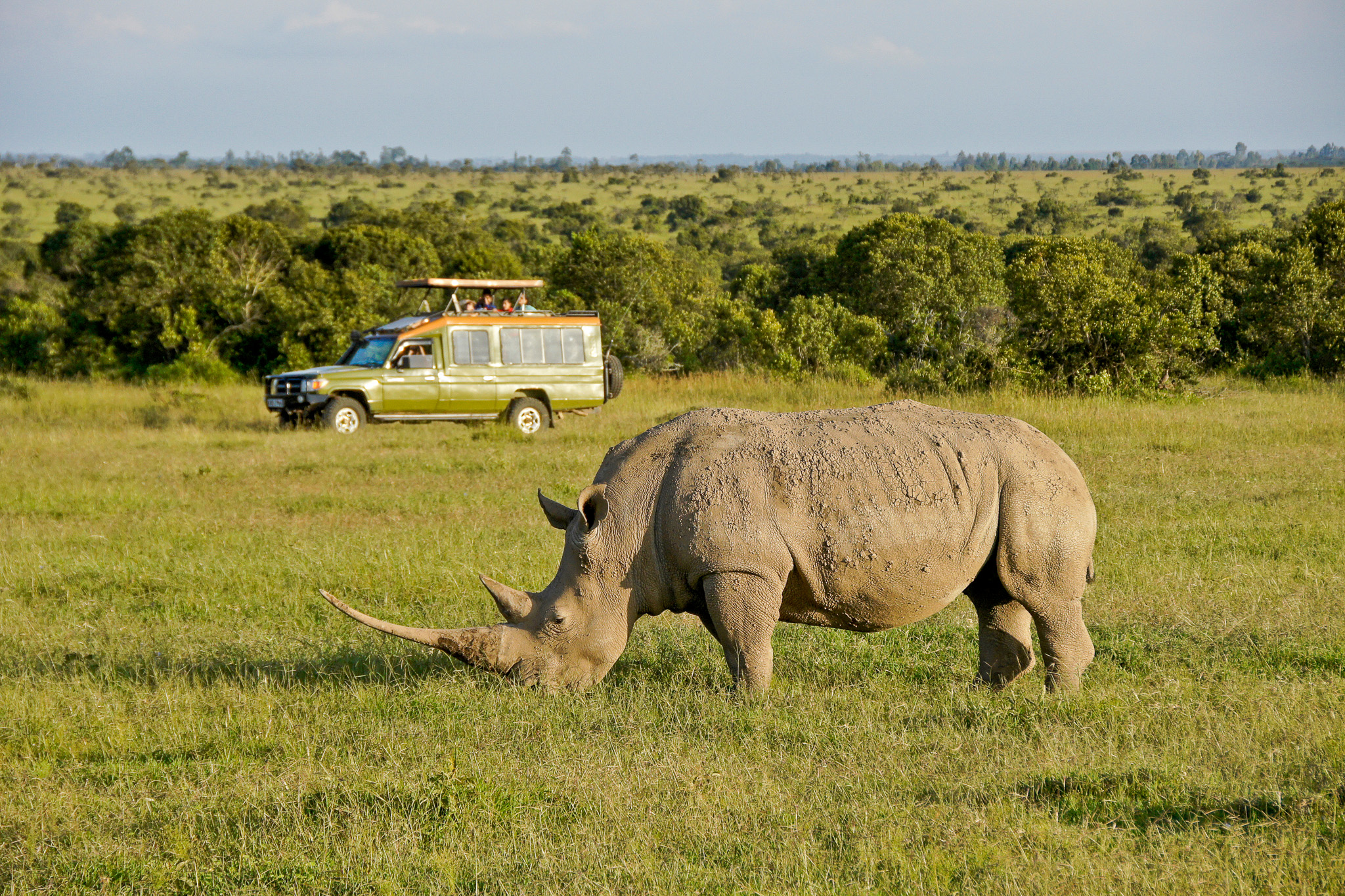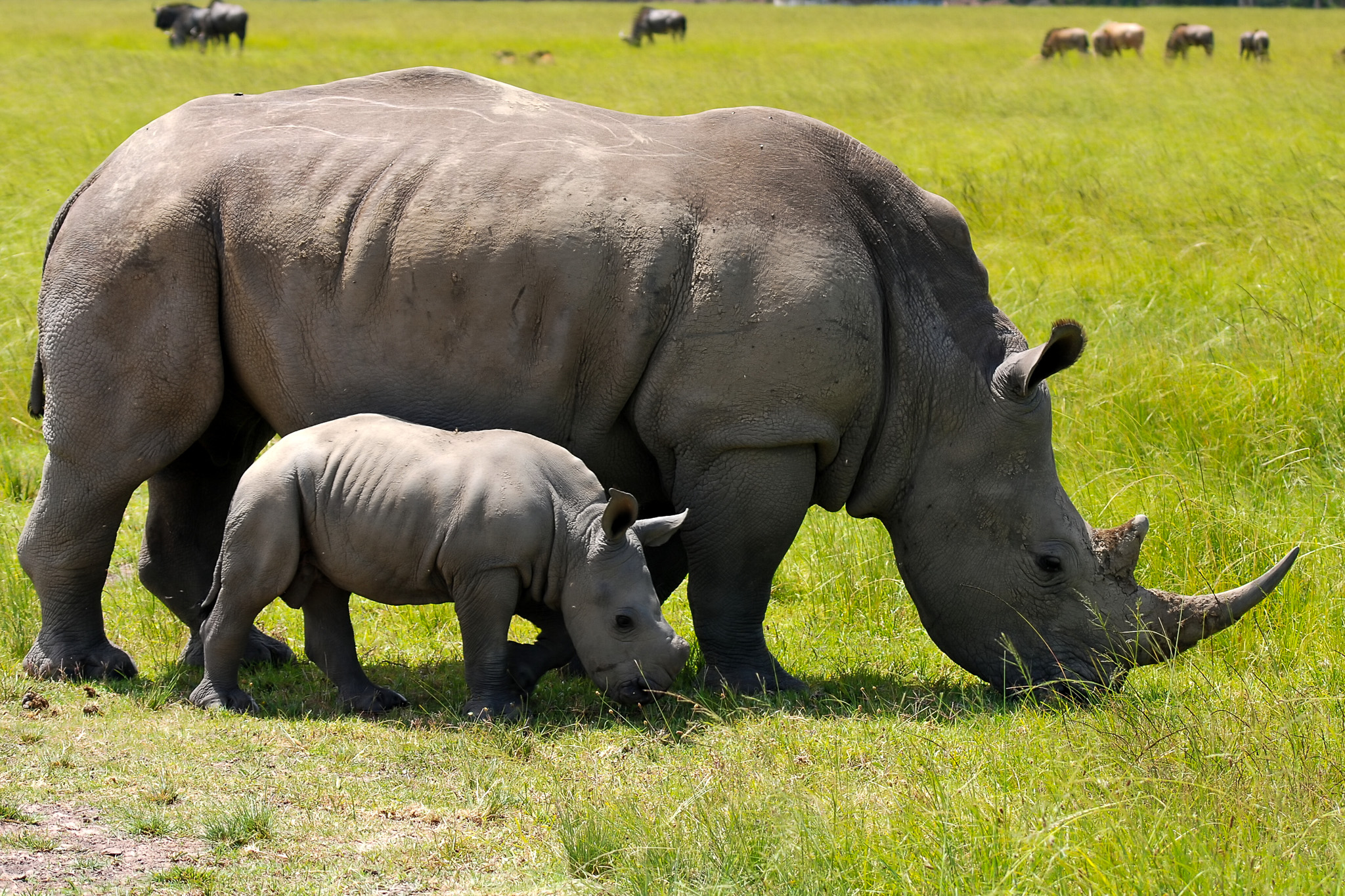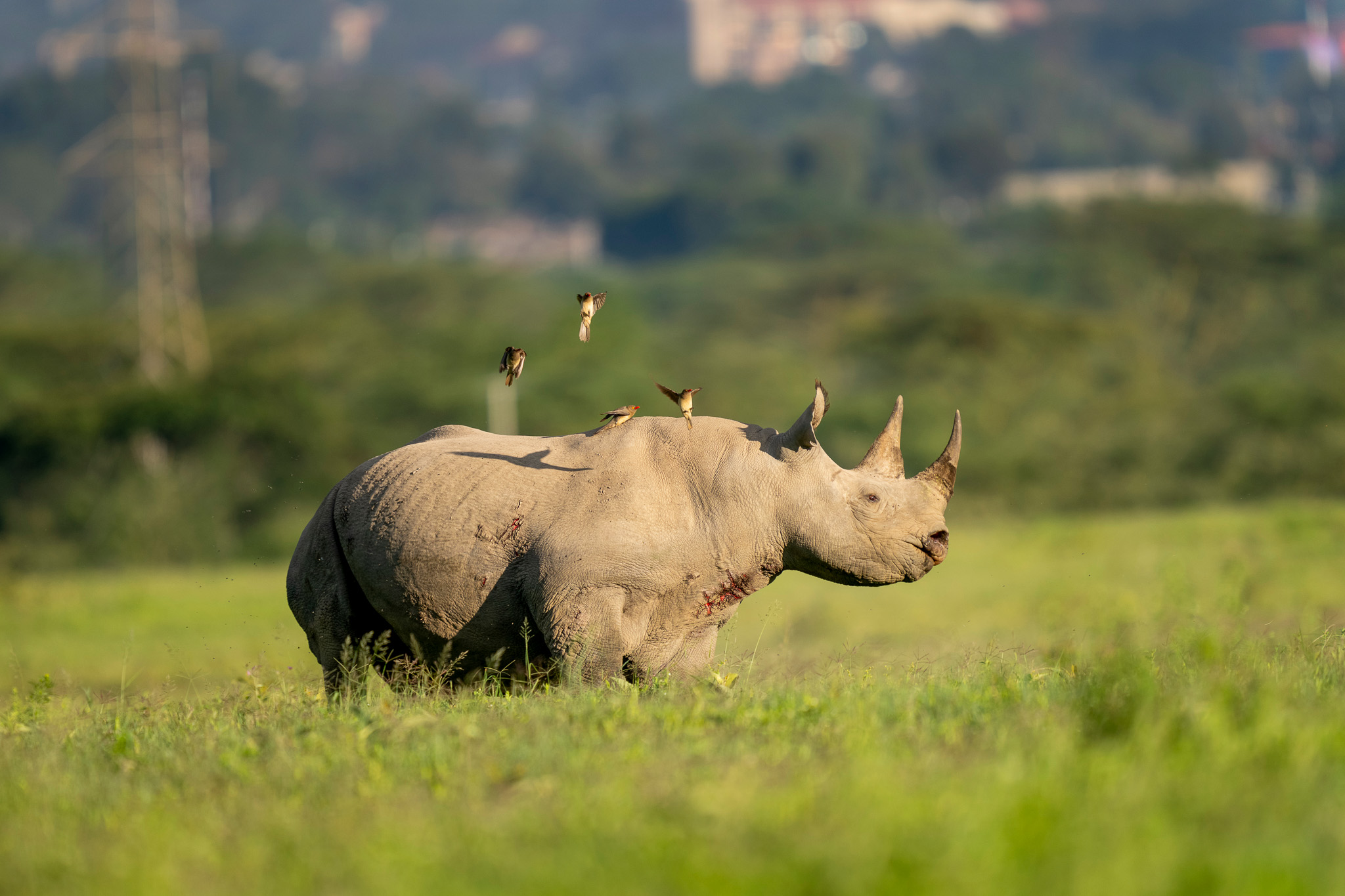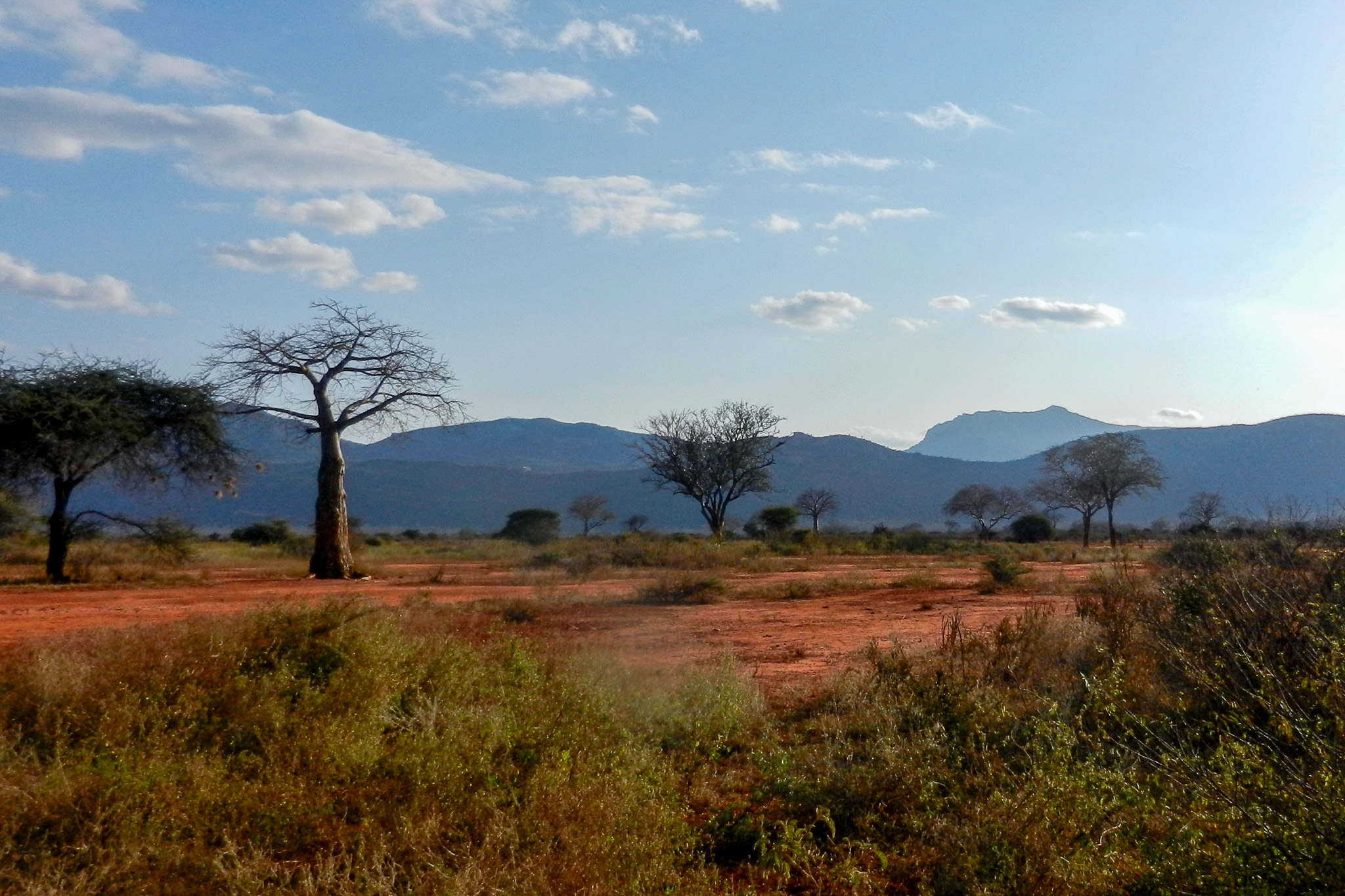Saving Africa’s Rhinos: Lessons from the Frontlines of Conservation

Tourists in safari vehicle view white rhinoceros grazing at Ol Pejeta Conservancy, Kenya
World Rhino Day is more than a symbolic date—it’s a reminder of what’s at stake for Africa’s most iconic species. With just over 22,500 rhinos left on the continent, these animals remain on the edge of survival. For decades, poaching and habitat loss nearly pushed them to extinction.
Yet there is hope. Thanks to conservation interventions, black rhinos are slowly increasing by 5.2%, and poaching has fallen to its lowest levels since 2011. But the future of both black and white rhinos remains fragile—and securing that future depends on a holistic approach that blends science, community leadership, and global support. Dr. Murithi reflects on the status of these species through this question and answer session.

Rhino mum and baby grazing
Q: Where do Africa’s rhinos stand today?
Dr. Muruthi: If we zoom out across the continent, the overall population of Africa’s rhinos appears stable—but that’s a qualified stability. As of 2024, Africa hosts an estimated 22,540 rhinos. While this is only a slight increase from the 2021 figures, the trajectory differs between species. Black rhinos have recorded a 5.2% increase in population, while white rhinos have declined, mainly due to poaching. Interestingly, poaching itself has decreased in the past year—down by 2.1%, the lowest since 2011—but the cumulative effect of past poaching incidents, combined with threats like drought, habitat fragmentation, and poor biological management, have kept the numbers from rising significantly. These threats don’t act in isolation—they’re synergistic and tackling them requires a holistic approach.
Q: What interventions are delivering real gains in rhino conservation?
Dr. Muruthi: Poaching remains the primary threat, and tackling it has yielded significant gains. But it is not enough. In Africa, especially Kenya, we’ve embraced metapopulation management—connecting isolated rhino populations through strategic translocations to boost genetic health. We also invest in habitat security. For instance, by the mid-1980s, Kenya’s rhino numbers had plummeted from around 20,000 to just about 350. The response was to create fenced sanctuaries such as Ngulia to protect and rebuild populations. These sanctuaries are not permanent solutions—the goal is to allow rhinos to roam freely once populations are viable. Furthermore, addressing consumer demand in countries like Vietnam and China is essential. When demand disappears, so does the incentive to poach. Other key interventions have seen us deal with other threats too.
Q: What’s new in the African Rhino Conservation Framework (2025–2035)?
Dr. Muruthi: The African Rhino Conservation Framework (2025–2035) introduces a transformative shift in the way rhino conservation is approached across the continent. Until now, most rhino range states have relied on their own national action or recovery plans. These plans, while comprehensive and involving multiple government sectors such as wildlife authorities, finance, and land ministries, have largely operated in silos. What has been lacking is a unified, continental strategy that brings these individual efforts together under a common vision.

Rhino grazing with city skyline in the background
Developed by the IUCN African Rhino Specialist Group in collaboration with range state governments, NGOs, and scientific experts—including the African Wildlife Foundation—the new framework responds to this gap. It builds on the traditional pillars of rhino conservation such as anti-poaching efforts, habitat protection, and ecological management, but goes further by embedding forward-looking strategies that reflect the urgency of the current conservation landscape.
It gives greater weight to local stakeholder engagement, ensuring that conservation is not just a top-down approach but one rooted in equity and community participation. It also calls for stronger cross-border cooperation, encouraging successful range states to share lessons, tools, and resources with those still struggling.
Importantly, the framework redefines the value of rhinos—not just as a charismatic species needing protection, but as ecological engineers essential to the health of African landscapes.
It also recognizes that time is not on our side and that only through coordinated, inclusive, and science-driven strategies can Africa secure a future for its rhinos and the ecosystems they sustain.
Q: Why do rhinos perform better on private and community lands?
Dr. Muruthi: Management and security are the key differentiators. Private conservancies like Solio and Lewa invest heavily in anti-poaching units, habitat quality, and sustainable financing. These sites often have more focused governance and can attract funding more easily than some overstretched national parks. They also perceive rhinos as assets, leading to better care and innovation. In contrast, some national parks suffer from resource limitations and porous boundaries, making them vulnerable. Effective biological management, incentives for communities, and strategic expansion of space are what make private lands so successful.
Q: What does people-centered conservation look like in practice?
Dr. Muruthi: In Tsavo, Kenya where AWF helped establish Ngulia Rhino Sanctuary, community-led conservation is already unfolding. At a recent workshop, members of Taita Ranch and LUMO Conservancy asked that rhinos be allowed to roam onto their lands. They see rhinos as heritage and a potential source of tourism income. This represents the future—conservation where communities are stewards and beneficiaries. Including them reduces the need for heavy security investment because the community becomes the first line of defense. People-centered models are built on mutual benefit and shared responsibility.
Q: What makes Ngulia Sanctuary a model for rhino conservation?

Ngulia Rhino Sanctuary in Tsavo West National Park
Dr. Muruthi: Ngulia succeeds due to consistent investment in management, infrastructure, and adaptive strategy. With over 130 black rhinos in a fenced sanctuary, it plays a critical role in Kenya’s recovery plan. However, fenced areas have limits—when carrying capacity is exceeded, rhinos fight, reproduction slows, and mortality increases. Ngulia demonstrates why range expansion is the next critical step—not just for Tsavo but for rhino sanctuaries across Africa.
Q: What is AWF’s role in enabling rhino range expansion?
Dr. Muruthi: AWF acts as a convener, planner, and implementer. We support government agencies in developing sound conservation plans and engage with communities to ensure their buy-in. In Tsavo for instance, we are helping coordinate dialogue between Kenya Wildlife Service, private landowners, and local communities. We also support research at Ol Pejeta Conservancy, in Kenya which houses the last northern white rhinos and leads in genetic rescue. The future of rhinos lies in partnership—between science, policy, and local action.